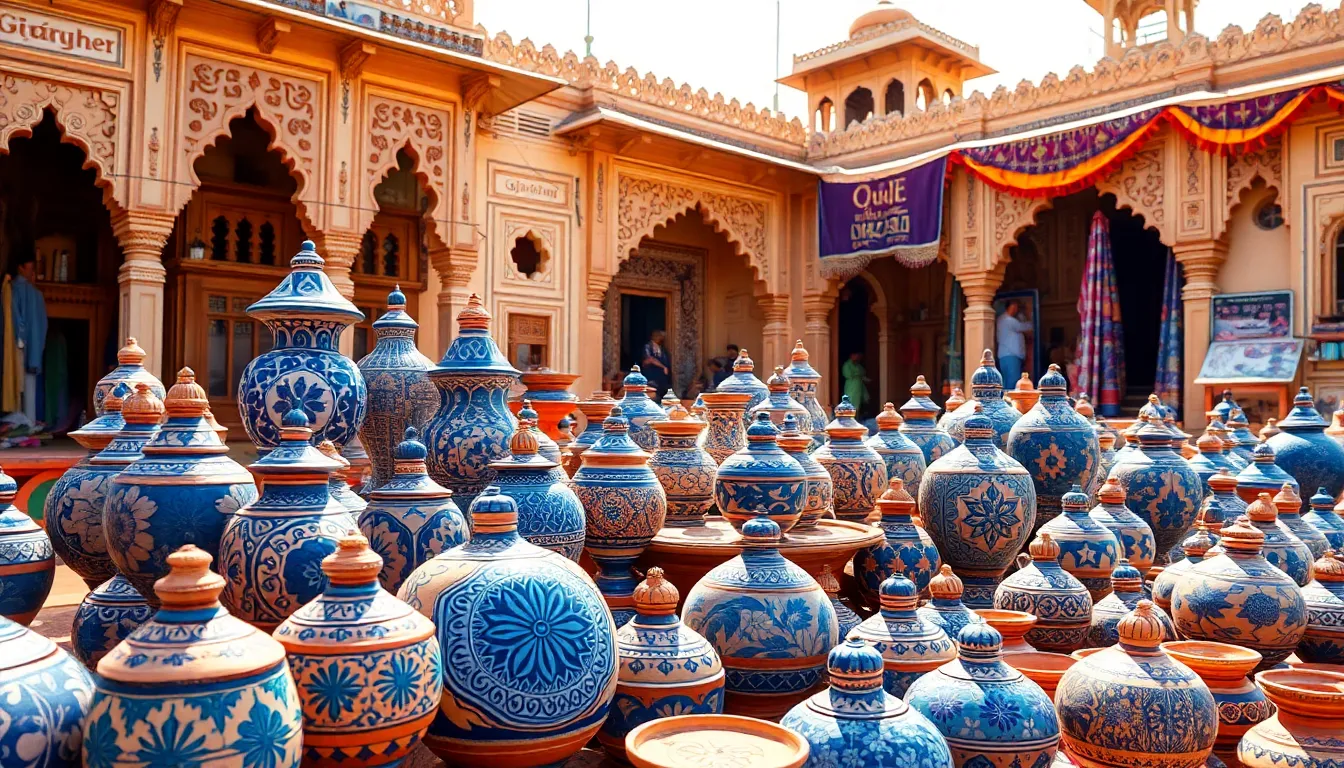The captivating tradition of Jharaahar represents one of India’s most treasured cultural ceremonies, deeply rooted in the rich heritage of Rajasthan. This ancient practice, characterized by its vibrant displays and symbolic rituals, has been passed down through generations as a way to honor divine entities and celebrate auspicious occasions.
In modern times, Jharaahar continues to fascinate both locals and tourists alike, drawing attention for its spectacular visual elements and profound cultural significance. The ceremony typically involves elaborately decorated structures, traditional music, and communal participation that strengthens social bonds within communities. As interest in authentic cultural experiences grows, Jharaahar stands as a testament to India’s enduring traditions that have withstood the test of time.
Table of Contents
ToggleWhat Is Jharaahar: Understanding This Unique Concept
Jharaahar is a traditional ceremonial display from Rajasthan, India that represents both artistic expression and cultural devotion. This elaborate arrangement consists of decorated clay pots, figurines, and symbolic items carefully arranged on multi-tiered platforms, creating a visually striking representation of local traditions.
The word “Jharaahar” derives from two Sanskrit terms: “jhara” meaning cascade or flowing display, and “aahar” referring to an offering or presentation. This etymology reflects the cascading arrangement of decorative elements that characterize this cultural practice.
At its core, Jharaahar serves as a devotional offering to deities during festivals, weddings, and special occasions. The arrangement typically includes:
- Decorated Clay Pots: Painted with intricate designs and symbolic motifs
- Ritual Objects: Items like coconuts, betel nuts, and religious symbols
- Figurines: Representations of deities and cultural icons
- Colorful Fabrics: Textiles in vibrant colors that enhance the visual appeal
- Traditional Artwork: Hand-crafted elements specific to Rajasthani culture
The cultural significance of Jharaahar extends beyond its aesthetic appeal. Each element incorporated into the display carries specific symbolic meaning, connecting participants to their ancestral heritage and religious beliefs. The practice embodies Rajasthan’s artistic traditions while serving as a medium for community bonding during important celebrations.
The Cultural Significance of Jharaahar
Jharaahar embodies profound cultural significance throughout Rajasthan, serving as a living testament to the region’s spiritual values and artistic heritage. This ceremonial tradition transcends mere decoration to become a powerful medium of cultural expression and community identity.
Historical Origins and Evolution
The historical roots of Jharaahar trace back to the 16th century during the height of Rajput influence in northwestern India. Early versions emerged as temple offerings during seasonal festivals, with clay artisans crafting specialized items exclusively for religious ceremonies. Historical records from the courts of Mewar and Marwar kingdoms document the gradual transformation of Jharaahar from purely religious displays to ceremonial installations marking royal occasions and family celebrations. During the 18th-19th centuries, the practice evolved to include more elaborate artistic elements, incorporating influences from Mughal aesthetics while maintaining its distinctly Rajasthani character. Colonial-era documents mention these “tiered displays of devotional art” as unique cultural markers of the region, fascinating British observers who encountered them during formal visits to princely states.
Regional Variations of Jharaahar
Jharaahar displays exhibit distinctive regional characteristics across different parts of Rajasthan. In Jodhpur, artisans emphasize indigo and cobalt blue motifs on clay elements, reflecting the city’s historic connection to blue pottery traditions. Jaipur’s Jharaahar incorporates miniature paintings and gemstone embellishments, showcasing the region’s lapidary expertise. The desert communities of Jaisalmer create sand-art embellishments on their displays, using naturally occurring minerals for coloration. Udaipur’s variation features water imagery and lake motifs, honoring the city’s famous lakes. Eastern Rajasthan incorporates agricultural symbols into their arrangements, with wheat stalks and millet representing prosperity. These regional variations evolved in response to local materials, artistic traditions, and the specific cultural narratives important to each community, creating a rich tapestry of expression within the broader Jharaahar tradition.
Key Elements and Characteristics of Jharaahar
Jharaahar displays feature distinct elements that distinguish this Rajasthani tradition from other ceremonial practices. These characteristics encompass both material components and symbolic representations that have been refined over centuries, creating a visually stunning and spiritually significant experience.
Traditional Practices and Rituals
Traditional Jharaahar ceremonies follow precise protocols established through generations of practice. The creation process begins with purification rituals where artisans cleanse themselves and their workspace before crafting the display elements. Clay pottery forms the foundation, with artisans using techniques passed down through family lineages to create vessels of varying sizes, each adorned with regional motifs using natural pigments like turmeric, indigo, and vermilion.
The arrangement follows a hierarchical structure with larger pots at the bottom and progressively smaller items toward the top, creating the characteristic cascading effect. Women typically lead the assembly process, singing devotional songs while positioning each element according to established patterns. The central tier often features a sacred lamp (diya) symbolizing divine presence, surrounded by offerings of grains, sweets, and seasonal fruits.
Key ritualistic aspects include:
- Invocation ceremonies involving the recitation of specific mantras and prayers before the display is assembled
- Water rituals where consecrated water is sprinkled on completed displays to activate their spiritual potency
- Communal processions carrying elaborate Jharaahar displays through village streets during festivals
- Offering exchanges between families during weddings, symbolizing the union of two households
Seasonal variations influence both the materials used and the symbolic elements incorporated, with harvest-time displays featuring newly gathered grains and winter celebrations including items representing warmth and prosperity.
Modern Interpretations
Contemporary Jharaahar practices have evolved while maintaining their cultural essence. Urban adaptations now incorporate modern materials like colorful synthetic fabrics, glass beads, and metallic paints alongside traditional elements. Commercial Jharaahar kits with pre-made components have emerged, making the tradition accessible to those without traditional crafting skills.
Tourism has significantly influenced Jharaahar’s evolution, with:
- Demonstration workshops where visitors learn basic Jharaahar assembly techniques
- Miniaturized versions created specifically as souvenirs and decorative pieces
- Fusion displays incorporating elements from different Rajasthani regions for cultural showcases
- Digital documentation through photography and video, preserving traditional forms while enabling wider appreciation
Cultural institutions and heritage organizations now regularly host Jharaahar exhibitions that showcase both historical and contemporary interpretations. Artists have begun incorporating Jharaahar aesthetics into modern art installations, fashion design, and interior decoration, creating cross-cultural connections while honoring the tradition’s roots.
Despite these innovations, community elders remain actively involved in guiding younger generations, ensuring that modern adaptations respect the core spiritual and cultural significance of this distinctive Rajasthani tradition.
The Impact of Jharaahar on Local Communities
Jharaahar transforms local Rajasthani communities through economic, social, and educational dimensions that extend far beyond its ceremonial significance. This cultural practice creates ripple effects throughout villages and towns where it remains an integral tradition.
Economic Benefits
Jharaahar stimulates significant economic activity in Rajasthani communities through multiple channels. Local artisans who specialize in clay pottery, fabric painting, and decorative items earn 30-40% of their annual income from Jharaahar-related sales during festival seasons. In tourism-heavy regions like Jaipur and Udaipur, Jharaahar workshops and demonstrations generate approximately ₹20-25 million annually through visitor participation fees and souvenir purchases.
The tourism sector benefits substantially as Jharaahar ceremonies attract domestic and international visitors seeking authentic cultural experiences. Hotels and guesthouses in districts like Jodhpur and Jaisalmer report 15-20% higher occupancy rates during major Jharaahar festivals. The tradition has created specialized employment opportunities including:
- Ceremonial arrangers who organize displays for families without expertise
- Material suppliers who source specific clay, fabrics, and decorative elements
- Tour guides specializing in cultural heritage experiences
- Workshop instructors teaching traditional Jharaahar techniques
Social Cohesion and Identity
Jharaahar ceremonies function as powerful community bonding experiences that strengthen social relationships across different demographics. During preparation phases, multiple generations work together, with elders sharing cultural knowledge and younger participants contributing new ideas while maintaining core traditions. These collaborative efforts typically involve 8-12 family members working over 3-5 days.
The tradition reinforces community identity through:
- Collective participation in village-wide displays during festivals like Gangaur and Teej
- Inter-community exchanges where neighboring villages share unique stylistic elements
- Revival of almost-forgotten local folklore through figurines and display narratives
- Creation of shared memories that strengthen familial and community bonds
Research by the Rajasthan Cultural Heritage Foundation found that communities with active Jharaahar traditions report 22% higher scores on social cohesion metrics compared to areas where the practice has declined.
Educational and Cultural Preservation
Jharaahar serves as an educational platform where cultural knowledge transfers organically between generations. The process of creating displays involves teaching:
- Traditional artistic techniques including clay molding, painting, and textile work
- Regional folklore and mythological stories depicted in the displays
- Seasonal agricultural knowledge reflected in symbolic offerings
- Religious and philosophical concepts embedded in ceremonial elements
Local schools in Rajasthan have incorporated Jharaahar into cultural curriculum, with 156 institutions now featuring dedicated programs teaching the tradition’s history and techniques. Cultural preservation efforts include documentation projects recording the variations of Jharaahar across 24 districts, creating comprehensive digital archives of this living heritage.
Museums and cultural centers throughout Rajasthan have established permanent Jharaahar exhibits, attracting 175,000+ visitors annually who learn about this distinctive tradition, further reinforcing its cultural significance and ensuring its continuation for future generations.
How to Experience Jharaahar Authentically
Finding Local Celebrations
Authentic Jharaahar experiences begin with locating genuine local celebrations rather than tourist-oriented shows. Visitors can connect with these authentic displays by consulting local tourism offices in Rajasthan cities like Jaipur, Jodhpur, and Udaipur for upcoming festival dates. Community centers and temples often post announcements about Jharaahar ceremonies, particularly during major Hindu festivals such as Diwali, Holi, and Navratri. Establishing relationships with local families through homestays provides insider access to private Jharaahar celebrations. Several annual cultural events feature traditional Jharaahar displays, including the Pushkar Fair (November), Jaipur Literature Festival (January), and Gangaur Festival (March-April).
Participating in the Creation Process
Immersive understanding of Jharaahar comes through direct participation in the creation process. Several artisan workshops in Rajasthan offer hands-on experiences where visitors learn traditional techniques from master craftspeople. In Jaipur’s Sanganer district, multi-generational pottery families teach clay pot decoration with traditional motifs and patterns. Community centers in Jodhpur conduct weekly sessions where travelers join local women in assembling small Jharaahar displays. Craft villages like Shilpgram near Udaipur host regular demonstrations where visitors practice arranging symbolic elements according to traditional hierarchies. These participatory experiences typically last 2-3 hours and provide deeper insights into the cultural significance behind each component.
Understanding the Symbolic Elements
Appreciating Jharaahar fully requires comprehending the rich symbolism embedded in its displays. Clay pots represent prosperity and abundance, with their number and arrangement varying based on the occasion’s significance. Figurines depict deities, animals, and people relevant to specific ceremonies—elephants symbolize good fortune, peacocks represent beauty, and certain deities correspond to particular celebrations. Color choices carry distinct meanings: red signifies fertility and marriage, yellow represents prosperity, and green symbolizes growth and renewal. Textile elements like embroidered cloths display regional artistic traditions while enhancing the visual appeal. Small mirrors incorporated in displays symbolize truth and self-reflection while adding luminosity to the arrangement.
Respectful Observation Etiquette
Experiencing Jharaahar respectfully demonstrates cultural appreciation and enhances the authenticity of the experience. Visitors should dress modestly when attending ceremonies, with women covering shoulders and knees and men wearing long pants. Photography permissions vary by location—always ask before taking pictures, especially during devotional moments. During religious aspects of Jharaahar ceremonies, maintaining a respectful distance allows participants to complete rituals uninterrupted. Removing shoes before entering temple spaces or homes where Jharaahar displays are housed shows proper respect. Small gestures like accepting offered prasad (blessed food) with the right hand acknowledges local customs and builds goodwill with community members.
Seasonal Considerations for Visitors
Timing visits to coincide with optimal Jharaahar viewing opportunities enhances the authentic experience. Winter months (October-February) offer the most comfortable climate for exploring Rajasthan while coinciding with major festivals featuring elaborate Jharaahar displays. The wedding season (November-December and February-March) presents opportunities to witness matrimonial Jharaahar arrangements in their full splendor. Regional festivals create distinct Jharaahar viewing opportunities—Gangaur in spring features female-centric displays, while Diwali in autumn showcases light-themed arrangements. Rural areas often maintain more traditional forms of Jharaahar compared to urban centers, making villages ideal for experiencing historical variations. Monsoon season (July-September) generally has fewer public displays but offers the chance to see how seasonal materials influence Jharaahar creations.
Preserving Jharaahar for Future Generations
Jharaahar preservation requires deliberate efforts from multiple stakeholders to ensure this unique Rajasthani tradition continues to thrive. Modern challenges including urbanization, changing lifestyles, and technological distractions threaten to diminish the practice of this intricate ceremonial art form. However, several effective preservation strategies have emerged across communities, organizations, and government initiatives.
Documentation and Digital Archiving
Digital preservation serves as a crucial safeguard for Jharaahar’s cultural legacy. Regional museums and cultural institutions actively document traditional Jharaahar displays through:
- High-resolution photography capturing the intricate details of ceremonial arrangements
- Video documentation recording the complete assembly process and associated rituals
- 3D scanning technology preserving the dimensional aspects of historical displays
- Oral history recordings from elder practitioners sharing techniques and symbolic meanings
The Rajasthan Digital Heritage Foundation maintains an extensive online archive with over 500 documented Jharaahar displays from various districts, creating a valuable reference for researchers and future generations.
Educational Programs and Knowledge Transfer
Educational initiatives form the backbone of Jharaahar preservation. These programs include:
- School curriculum integration in Rajasthan’s educational system, introducing students to Jharaahar’s cultural significance
- Apprenticeship programs pairing elder artisans with younger community members for hands-on training
- Weekend workshops in urban centers allowing families to learn traditional techniques
- University research programs studying the sociological and artistic aspects of Jharaahar
The Jaipur Craft Council runs a dedicated “Young Keepers” program that has trained 1,200 children in traditional Jharaahar techniques since 2015, ensuring continuity of knowledge.
Community Engagement and Revitalization
Local communities remain the primary guardians of the Jharaahar tradition, with revitalization efforts including:
- Annual Jharaahar competitions in villages and urban neighborhoods encouraging participation
- Community celebrations spotlighting master artisans and innovative displays
- Cross-generational gathering events where elders share stories and techniques
- Social media communities connecting practitioners across geographical boundaries
In Jodhpur, the annual Jharaahar Mahotsav attracts over 5,000 participants from 75 surrounding villages, reviving interest among younger generations through competitive displays and cultural exchange.
Policy Support and Government Initiatives
Governmental recognition provides essential structural support for Jharaahar preservation:
- GI (Geographical Indication) certification protecting the authentic regional practice
- Cultural heritage grants funding community preservation projects
- Tourism promotion highlighting Jharaahar as a unique cultural attraction
- Artisan support programs providing materials and financial assistance
The Rajasthan Department of Cultural Affairs allocated ₹1.5 crore in 2022 specifically for Jharaahar preservation projects across 12 districts, demonstrating institutional commitment to safeguarding this tradition.
Innovation and Adaptation
Thoughtful adaptation ensures Jharaahar remains relevant without losing its core essence:
- Eco-friendly materials replacing traditional components that may be environmentally harmful
- Portable display formats accommodating modern housing limitations
- Themed contemporary displays addressing current social issues while maintaining traditional forms
- Mixed-media interpretations incorporating new artistic techniques while preserving symbolic elements
The Udaipur Arts Collective has successfully developed biodegradable alternatives for traditional materials, allowing continued practice while addressing environmental concerns.
Conclusion
Jharaahar stands as a living testament to Rajasthan’s cultural resilience and artistic ingenuity. This intricate ceremonial tradition continues to bridge generations while adapting to contemporary realities.
The future of Jharaahar looks promising as communities balance preservation with innovation. Through dedicated documentation efforts educational initiatives and tourism interest this cultural practice maintains its relevance in modern India.
For those seeking authentic cultural experiences Jharaahar offers a window into India’s spiritual heritage and artistic excellence. As both a devotional practice and community celebration it represents the harmonious blend of faith artistry and social bonding that characterizes Rajasthan’s enduring cultural landscape.






